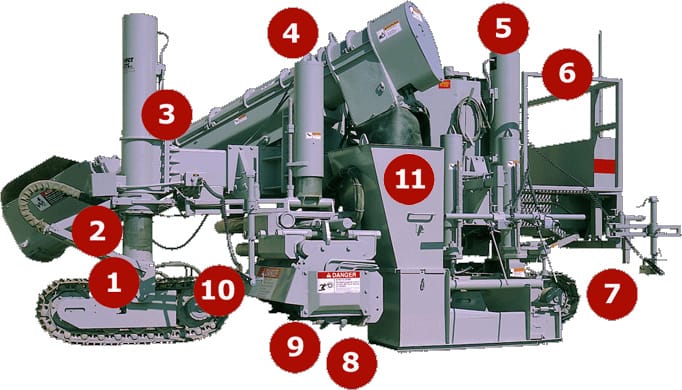What To Look For
Power Curbers includes manuals in each toolbox. Make sure you have the proper manuals and understand the operation of the machine. Go to Downloads for free manuals.

- Look for wear on the post. Deep grooves or scratches indicate excessive wear and/or poor maintenance. Newer machines have bushings to help limit post wear. Worn posts contribute to poor pouring quality because the machine is wobbling on the posts. Replacing the bushing should improve performance.
- Start the engine, turn on the servo system and operate the steering. The front crawler should move smoothly from side to side. Look for lost motion (slop) in the steering collar and both pins for the steering cylinder. Sloppy steering will make it difficult to pour straight.
- Operate the conveyor. The conveyor should start and stop with a smooth action. The conveyor should reverse directions easily. Worn flighting on auger conveyors and worn belting on belt conveyors must be replaced to achieve the highest rates of production.
- Refer to the owner’s and/or maintenance manuals for information on testing each of the hydraulic systems. The conveyor driver, crawler driver, and servo, vibrator and trimmer systems must operate well for good pouring results. Excessive leaks, heat or noise could indicate a damaged or poorly maintained hydraulic system
- Check the engine oil level, coolant level and hydraulic oil level. Some machines may use air-cooled engines. Make sure the engine and hydraulic cooling systems are clean. A dirty, plugged cooling system is a good warning sign of poor maintenance.
- As you are testing each of the systems, note how smoothly each control operates. Each function should start and stop precisely as indicated by the control. Any control that does not operate as designed must be replaced before use.
- Make sure the machine is clean and free of excessive concrete. Concrete build-up indicates lack of maintenance. Be sure all control labels and safety decals are in place and fully readable. Failure the have proper labels and warnings will create a safety hazard.
- Look for loose, rusted or damaged parts. Use the Power Curbers Parts Manual (Downloads) to determine if any parts are missing. Sensors and sensor mounts may be in the tool box. Be sure that they are in place and function correctly.
- Check the trimmer for wear. Missing or worn teeth or holders must be replaced in order to trim. Check the trimmer hydraulic motor for leaks and the trimmer torque hub for lubrication. The trimmer can be dangerous. Stay away from the trimmer when it is operating.
- Check the crawlers for proper chain tension and chain wear. Look for leaks at the crawler motors. Make sure the crawler torque hubs have proper lubrication. Low oil level or the smell of burnt oil in any of the torque hubs is a sign of damaged torque hubs.
- Make sure there are two functioning vibrators. The hopper should be free of excessive concrete. The vibrator mounts should be clean and easy to adjust.